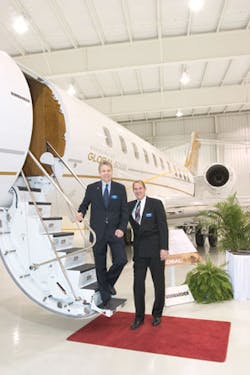Based in Aircraft Management
SAVOY, IL — When Bill Giannetti and Frank ‘Chip’ Hussey started Flightstar at the Willard Airport in 1978, they were a flight training startup. Today, Flightstar’s business is centered around aircraft management, maintenance — including airline maintenance — and line services. Through the years the company has migrated toward profit centers that could be sustained, in a market that’s dominated by the University of Illinois and nearby Champaign/Urbana. Flightstar management says that the growth in aircraft management has provided the company with a business on which to build for the future.
Executive vice president/CFO Hussey relates that he and Giannetti couldn’t qualify as military pilots, and in the late ‘70s pilot jobs were hard to find. “So we made our own flying jobs,” he says. “This was still a university airport; there was no fixed base operator here. We talked the director into letting us start a small flight training operation.
“We put a construction trailer out here and they gave us a long-term, six-month contract, figuring that’s how long it would take us to go broke.”
Willard Airport is owned and operated by the University of Illinois, which continues to offer a flight training curriculum and averages some 200-250 active students, says Hussey.
The flight training business was initially fruitful for Flightstar, explains Hussey, and the company grew to have as many as nine Pipers, from Tomahawks to Warriors to a Seminole, in the school. It had also become a Piper aircraft dealer.
“We stopped doing flight training about five years ago,” says Hussey. “The business was dwindling; we couldn’t raise the prices fast enough to keep up with the insurance premiums. It got to the point that we couldn’t figure out how to make any money with it. Insurance was the primary reason.”
To Charter, or Not
“We just decided to go someplace else,” comments Hussey. It’s been his and Giannetti’s trademark approach — get out of businesses that are increasingly difficult to profit on and find opportunities with more promise and future.
As Flightstar transitioned out of flight training in the 1980s, it moved more into charter. Starting first with a Piper Aztec and a Beech Bonanza, the company slowly added piston singles and twins to its charter certificate. Turbojets entered the picture in the 1990s.
Explains Hussey, “The charter business has always had its ups and downs. Today, the majority of our [flight] business is for managed aircraft for the owners. Five to ten percent of our business is charter flights.”
Hussey adds that the company has never owned its charter aircraft, and that the company has never figured out how to make charter profitable when Flightstar actually owned the airplanes. “We used to own the training fleets and a portion of one of the King Airs; not anymore.”
Flightstar today manages nine local aircraft — two Falcon 900s; two Falcon 20-F5s; three Falcon 10s; and, a King Air 200. Some of the fleet will transition over the next several years as current owners take on replacement business jets. New aircraft expected to come on line include two Lear 45s, a Global 5000, and a Global XRS, according to Hussey.
Placing a greater emphasis on managing others’ aircraft, providing turnkey crew and maintenance services, has brought a level of stability to the business, says Hussey. “It allowed us to stabalize a bit because now you aren’t subject to the ups and downs of the charter world,” he says. “The managed world is the same as a flight department.
“One of the things that we see that’s kind of unique is that we have lost very few clients, ever. The same airplanes stay here. Our very first Falcon jet that we managed for a company in town has been sold in town four times, and it’s still here. Nothing changed as far as we’re concerned. It’s just four different owners. One would upgrade to a larger aircraft and somebody else in town would buy the old airplane.”
Three Primary
Profit Centers
In its first year, Flightstar recorded revenues of $242,473, according to Hussey; today, it generates some $11 million in annual revenues. The company has over 90 employees, a third of which are in maintenance and avionics. Besides a modern FBO terminal building, Flightstar has six hangars, the largest 26,000 square feet. One hangar is dedicated to overnight maintenance for American Eagle, which has grown into a significant profit center. American Eagle and Mesaba (for Northwest) are the lone carriers serving Willard.
Comments Hussey, “We maintain five American Eagle Embraer 135s, seven days a week. It started with a call from American Eagle asking if we can kick the tires, check the lights. Now we do pretty much anything the airplane needs — clear the MELs (minimum equipment lists); do the APU changes; windshield changes; engine changes.
“We also do the cleaning for their Midwest fleet. They cycle their aircraft in here for carpet changes, seat cover changes, interior work. Our guys are specialists in repairing fuel leaks. We’re actually one of the few stations that enjoys working on lavatory systems.”
Looking ahead, Hussey says growth for Flightstar will come from continuing to focus on its three core businesses — aircraft management; maintenance; and line services. The company expects to pump some 1.7 million gallons this year.
The business here is primarily local; its Central Illiniois location is not attractive to cross-country transients. Flightstar is looking to grow its general aviation maintenance business in particular, but the Central U.S. market is competitive.
Says Hussey, “We have a quality maintenance base for turbines. But there are some pretty good maintenance bases nearby — Premier; Landmark; Midcoast; and not too far away two Duncan facilities.”
